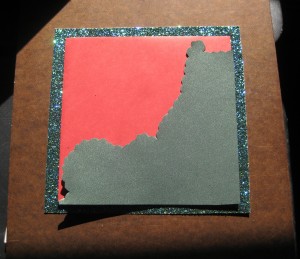WEEK 5: Ta’ziyeh
Colored Paper Artwork illustrating Taziyeh:
This week I was inspired by our study of the Shi’a “passion plays” called Ta’ziyeh (Shahidi 42). The word Ta’ziyeh means “mourning” or “consolation” (Chelkowski 2). In the Ta’ziyeh tradition, Imam Hussain and the family of the prophet (the “good guys”) are always depicted in green. The actors wear an article of green clothing, or some other green identifier. Shmr and the enemies of the family of the prophet, (the “bad guys”), are always depicted in red. The actors wear an article of red clothing, or some other red identifier. Anything that is on Hussein’s side is green, and anything that is against him or betrays him is in red.
I was interested by this color dualism as a visual representation of the idea of an eternal struggle between good and evil. Within the predominantly Judeo-Christian culture in which I grew up in Massachusetts, the dominant visual paradigm used to represent dualisms like good and evil was “black and white”. For this reason it surprised and interested me to learn that red and green could be used as signifiers of a similar relationship in another religious culture.
To visually illustrate this dualism, I created a piece of artwork using layers of green and red colored paper. The outer square which sparkles with many shades of green represents the prophet Muhammad, Hussein’s grandfather, whose life and works form the spiritual backdrop of Taziyeh. The overarching love of Muhammad (and Allah (Pelly 93)) surrounds and informs the story of Hussein. The center square is half red and half green, representing the dual nature of the human heart. Shi’a Muslims watching the Taziyeh participate in the play by crying, weeping, and feeling as if they are witnessing the betrayal and death of Hussein first hand. Unable to stop Hussein’s murder, they experience both the feeling of having betrayed him, and the overwhelming urge to serve and protect the family of the prophet. In this way, participants experience both good and bad within their own nature. The good part is more beautiful and arguably wins when religious and spiritual faith in Shi’a Islam is reinvigorated by the experience. (Some also believe acting out the play gains Hussein’s intercession on Judgement day. (Chelkowski 2))
